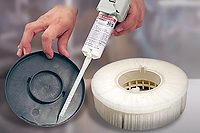Composite Repair




Many advances have been made in composite technology over the last few decades. Today, composites are used in industries ranging from aerospace to consumer electronics, domestic appliances and industrial machining, construction and automotive, and marine and sports equipment.
Composites, by definition, are an engineered or naturally occurring combination of two or more materials with notably different physical or chemical properties that retain their own identity, in that they are still distinguishable, and not fully blended after they are bonded or cured. These combinations produce a new material that features its own unique and superior characteristics.
Man has been making composites for centuries. One of the earliest noted man-made composite materials included straw and mud combined to form bricks for building construction. Composite materials take advantage of the strengths and abilities of different materials. In the example of straw and mud bricks, the mud is an outstanding binding material, but on its own, it will not stand up to compression and force very well. Straw, on the other hand, can withstand compression without crumbling or breaking. The combination of the two becomes an ideal composite solution for building construction.
ADHESIVES BRING COMPOSITES TOGETHER
As composite advancements have been made, newly engineered adhesives—specifically structural adhesives—have also been developed. These multi-purpose adhesives provide manufacturers the ability to construct new and improved product designs. As an integral part of numerous fabricated products, adhesives are now being recognized for their ability to not only form lasting bonds, but also to reduce the weight of composite parts. Adhesive layers weigh much less than bolts and rivets.
In addition, avoiding the need to drill holes for these fasteners circumvents the likelihood of water seeping in and causing rust and corrosion. Cutting fibers during the drilling process also reduces the composite’s strength; with adhesives, this hazard to the structural stability is avoided. Significant savings can also be seen in the reduction of labor previously needed to drill the holes and install the fasteners; in turn, this allows for more rapid production rates. Adhesives also offer a smoother, cosmetically improved surface finish.
TYPES OF COMPOSITE FAILURES
Composites fail for numerous reasons. Defects in a composite part may occur due to an improper manufacturing process, mishandled parts or even misassembled parts. Once in service, damage can occur as a result of operating and environmental conditions or from the mishandling of the part. Composites should be inspected regularly to ensure that any surface or hidden damage is detected and repaired according to engineering specifications.
Composites can fail on a micro or macro scale. The failure type is based on the location, thickness, type of material and the fiber orientation. Structural engineers must consider a composite’s function when determining failure level. Some defects may be considered more serious due to the composite’s importance in regard to the performance of the part, while other damages may be purely cosmetic in nature. In many cases, performing minor repairs when a defect or damage is first spotted can prevent major damage or even avoid complete composite failure.
NONDESTRUCTIVE INSPECTIONS
Whether the failure is due to a manufacturing defect, shock, impact, or repeated cyclic stresses, composite failures cause a condition known as delamination, in which the layers of the composite separate. These failures can sometimes be hard to detect during an inspection; however, various types of nondestructive inspections (NDI) can aid in failure detection. Visual inspection is the primary method of damage detection; however, only surface defects can be detected by this method, and often this initial inspection is unreliable in terms of accuracy.
The tap test can help determine delamination or other internal flaws, but this is not a fool-proof method either. By tapping along a bond line or area suspected of having delamination, variations in the tapping sound can be heard. Sharper solid sounds will be heard on a good bond, whereas a dull thud indicates bond separation. However, previous repairs or changes in the thickness of the part or fasteners can provide false positive results.
Ultrasonic inspection is more common and useful in detecting internal damage and delamination in composite parts. By beaming high-frequency sound waves though the part, an echo pattern can be viewed on an oscilloscope. Variations of a given response can detect delamination, flaws or other conditions.
X-rays can also be useful in detecting internal cracks, as well as surface cracks not visible to the naked eye. Once the film is developed, defects are show in contract with the undetected area. Cracks and moisture embedded inside the composite are indicated by darkened areas.
Additional inspection methods can include thermography, laser shearography, dye penantrant and hardness testing. When using the thermography method, heat is applied to the part and then the temperature gradients are measured using an infrared camera or film. Laser shearography uses a laser to quickly scan a large area for inspection. This technique has high lateral resolution and relatively large penetration depth. Dye penetrant has been used successfully for detecting cracks in metallic surfaces. Finally, hardness testing can be done to determine whether the resins have reached their proper strength. Hardness testing does not test the strength of the composite, just the bond’s strength.
TO REPAIR OR NOT TO REPAIR
Composite failures can be identified by three categories of damage or defects, including:
- Negligible or acceptable damage
- Repairable or correctable damage
- Non-repairable or rejectable damage
A negligible repair—also called acceptable damage or defect—may be corrected by simple procedures with no restrictions for the use of the repaired part. A non-repairable or rejectable composite part is one that has been damaged beyond repair limits (as determined by a structural engineer). This part must be rejected and/or replaced.
The decision to repair or scrap a composite is made, in part, by considering the extent of the repair needed to replace the original structural performance. Other considerations include the costs of the repair itself, the position and accessibility of the damage, and the availability of suitable repair materials.
REPAIRING COMPOSITE FAILURES
An easy repair, such as one that is purely cosmetic, is usually small and does not affect a part’s structural integrity. Cosmetic repairs are made to protect the surface of the component and do not require reinforcing materials.
Complex repairs, however, are needed when the damage interferes with the structural performance of the composite. It is sometimes necessary to make temporary repairs to the composite to keep severe mechanical problems at bay until it is possible to perform a complete repair. A patch can be fixed to the composite for a temporary repair using a belt and brace technique. This can be quick and easy to do, but this type of repair is thicker and heavier than the original bond, which may not be feasible in some situations.
If structural repairs to the composite are required due to delamination, reinforcing fiber will be needed to restore the original mechanical properties of the part. In
If structural repairs to the composite are required due to delamination, reinforcing fiber will be needed to restore the original mechanical properties of the part. |
making this type of repair, repair materials must overlap and be adequately bonded to the plies of the original laminate. A structural repair can be made using a taper-sanded or scarf repair. The advantage to this type of repair is that the repair is only marginally thicker than the original composite bond. In addition, each repair ply overlaps the ply that it is repairing, giving a straighter, stronger load path. The downside is that this type of repair is time consuming and requires a skilled technician.
Step-sanded repair requires a technician to sand the laminate down so that a flat band of each layer is exposed—resembling a stepped finish. The advantages and disadvantages of this process are the same as with the scarf repair in terms of thickness, strength and difficultly.
It is important to note that the actual repair procedures for composite structures can vary greatly by original equipment manufacturer (OEM), are not standardized between composite materials and are be dependent on the composite’s use.
For more information, contact Hernon Manufacturing at (866) 554-4005 or (407) 322-4000, or visit www.hernon.com.
Looking for a reprint of this article?
From high-res PDFs to custom plaques, order your copy today!






